I.
In March 2021, at the India Today Conclave, External Affairs Minister S. Jaishankar openly dismissed international democracy rankings.
You have a set of self-appointed custodians of the world, who find it very difficult to stomach that somebody in India is not looking for their approval...They invent their rules, their parameters, pass their judgements, and then make out as though this is some kind of global exercise.
S. Jaishankar
To Jaishankar, these rankings were not some neutral measure of governance. They were political tools wielded against countries that refused to follow Western-defined standards.
His comments were a direct response to India’s democratic downgrade by international agencies. Freedom House, the U.S.-based watchdog monitoring global democratic rights, had stripped India of its “free” status for the first time since the Emergency era of 1975-77, highlighting specific concerns such as increasing violence targeting Muslims, restrictions on civil society, and growing pressures on press freedom.
Around the same time, Sweden’s Varieties of Democracy Institute (V-Dem) went even further, bluntly stating that the world’s largest democracy could no longer be considered democratic. India had become, in their words, an “electoral autocracy”—a country that holds elections but lacks essential democratic safeguards.
Jaishankar’s message was clear: India rejected these assessments as irrelevant.
But if the rankings were truly irrelevant, the government would not have spent the preceding year tracking, analysing, and scrambling to counter them. Behind closed doors, these numbers did matter.
Nine months earlier, Sanjeev Sanyal, then Principal Economic Adviser in the Finance Ministry, had prepared a 36-page internal presentation revealing the depth of the government’s concern. (More details in this paper.)
His document, “Subjective Factors that Impact India’s Sovereign Ratings,” revealed how these seemingly academic rankings had very real consequences: they directly influenced the World Governance Indicators, a benchmark used by major credit rating agencies—such as Moody’s, Fitch, and S&P—to evaluate a country’s investment credibility. Lower democracy scores meant higher risk ratings, leading directly to increased borrowing costs.
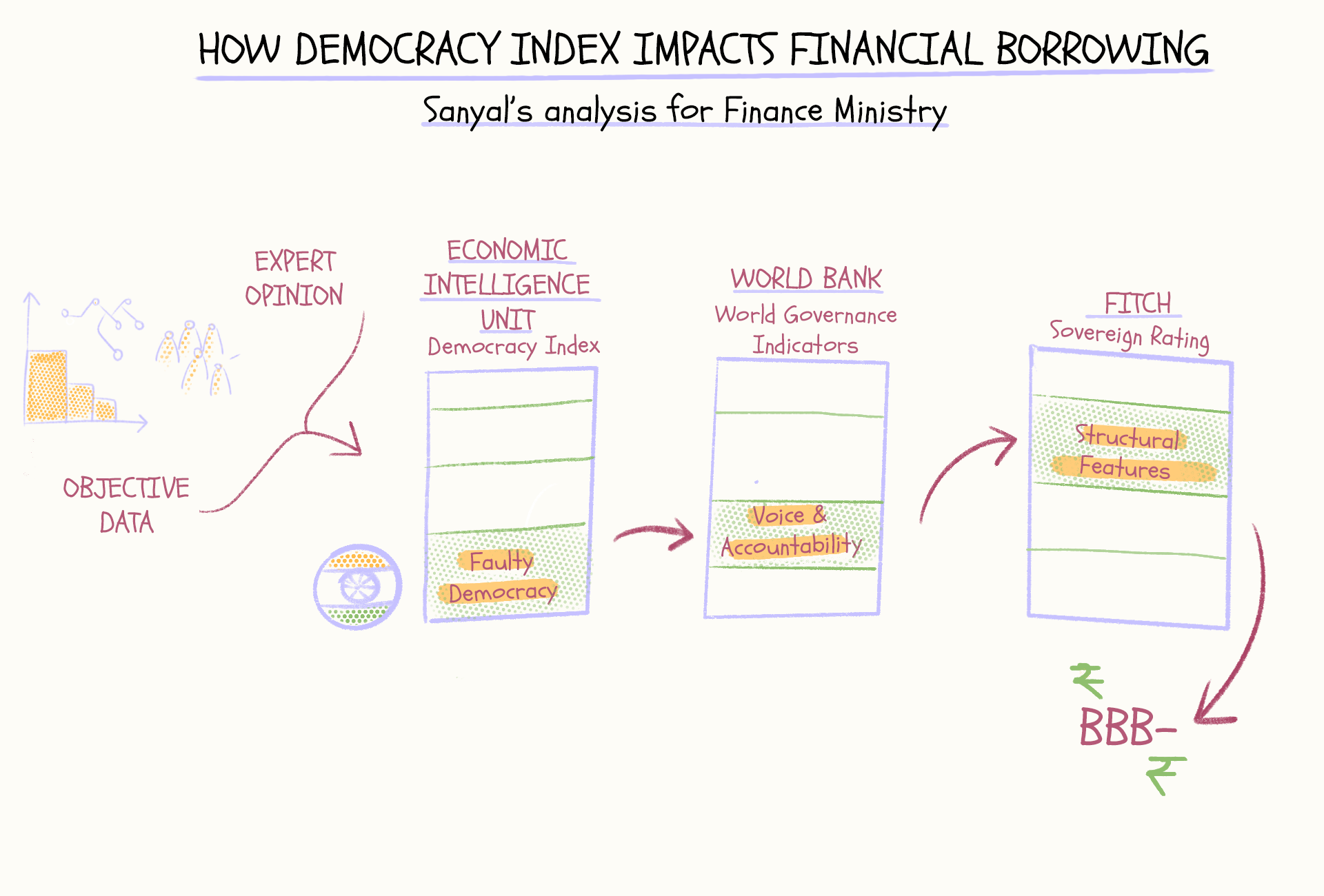
“In most cases, India’s ranking on these subjective factors is well below peers. This pulls down its sovereign ratings,” Sanyal warned.
The implications, he explained, were painfully practical: higher borrowing costs on international markets, weakened investor confidence, and potential barriers to critical development projects.
The government’s frustration centered on methodology. According to Sanyal, these influential ratings depended too heavily on subjective perceptions—surveys, expert opinions, and assessments from international organisations—rather than hard data. Many officials believed these sources were inherently biased against India.
“There is a danger,” Sanyal cautioned, “that we may witness a drop in WGI scores due to the latest negative commentary on India.”
The contradiction was striking. While ministers publicly dismissed these rankings as Western meddling, officials behind the scenes were calculating their financial impact. Two parallel realities existed—one crafted for public consumption, another guiding actual policy.
This is the story of how the Narendra Modi government responded when those realities collided. Over four years, I’ve tracked this response through internal documents, conversations with sources within the administration, and systematic observation of government reactions to international criticism.
It began as a conventional bureaucratic exercise to fix a ratings problem. It evolved into something else entirely: a blueprint for how a state can stop playing by established rules, and instead rewrite them to control the narrative.
II.
In early 2020, Cabinet Secretary Rajeev Gauba set up a high-level committee of secretaries with a specific mission: track India’s performance across 32 major global indices and find ways to improve it. The initiative was expansive, spanning multiple ministries and agencies, and covered indices across four categories: industry, development, economy, and governance. These include Global Climate Risk Index, Global Gender Gap Index, Corruption Perceptions Index, and Global Hunger Index.
The Democracy Index was also on this list, assigned to the Law Ministry.
These indices simplify complex national realities into scores and rankings, creating global benchmarks to measure progress and compare governance across countries. For the government, as NITI Aayog later explained, they were meant to “bring about reforms in policies” while also “presenting an accurate image of India to the world.”
Ministries were directed to analyse India’s rankings, identify areas of weakness, and recommend concrete actions to lift performance. The approach was meant to be systematic, data-driven, and results-oriented.
But governments don’t always reform in response to rankings—sometimes, they just “perform” for them. India had done this before.
Between 2014 and 2019, the Modi government aggressively sought improvements in India’s ranking on the World Bank’s Ease of Doing Business index. When Mr Modi took office, India ranked 142nd. By 2018, it had jumped to 77th. The next year, it climbed to 63rd.
It wasn’t a fluke: the government had reverse-engineered the ranking, strategically identifying procedural tweaks that directly boosted India’s scores in Delhi and Mumbai—the two cities evaluated by the World Bank.
For instance, the government eliminated the requirement for a company seal to register a business, simplifying one step of the process. It also digitised export documentation, marginally streamlining cross-border trade.
Each small adjustment incrementally raised India’s ranking. Yet, while these tweaks improved the measured ease of doing business, they didn’t necessarily reflect substantial improvement in the broader business environment.
This is the paradox at the heart of global indices: they can serve as diagnostic tools driving real reform—or become mere metrics that governments tactically manipulate.
The government now sought to understand how the Democracy Index was measured. While multiple organisations assess democratic governance, it chose to focus on the Economist Intelligence Unit (EIU), whose Democracy Index categorised India as a “flawed democracy”.
But improving a ranking isn’t just about understanding the methodology—it depends on shaping the inputs that go into it. And that’s what the government wanted to figure out with the EIU.
III.
The Law Ministry sought details on how the index worked—which data sources the EIU used, how scores were calculated, and whether information provided directly by the government was considered. The task was assigned to the Ministry of External Affairs (MEA), which instructed India’s High Commission in London to reach out to Fung Siu, EIU’s Principal Economist for Asia.
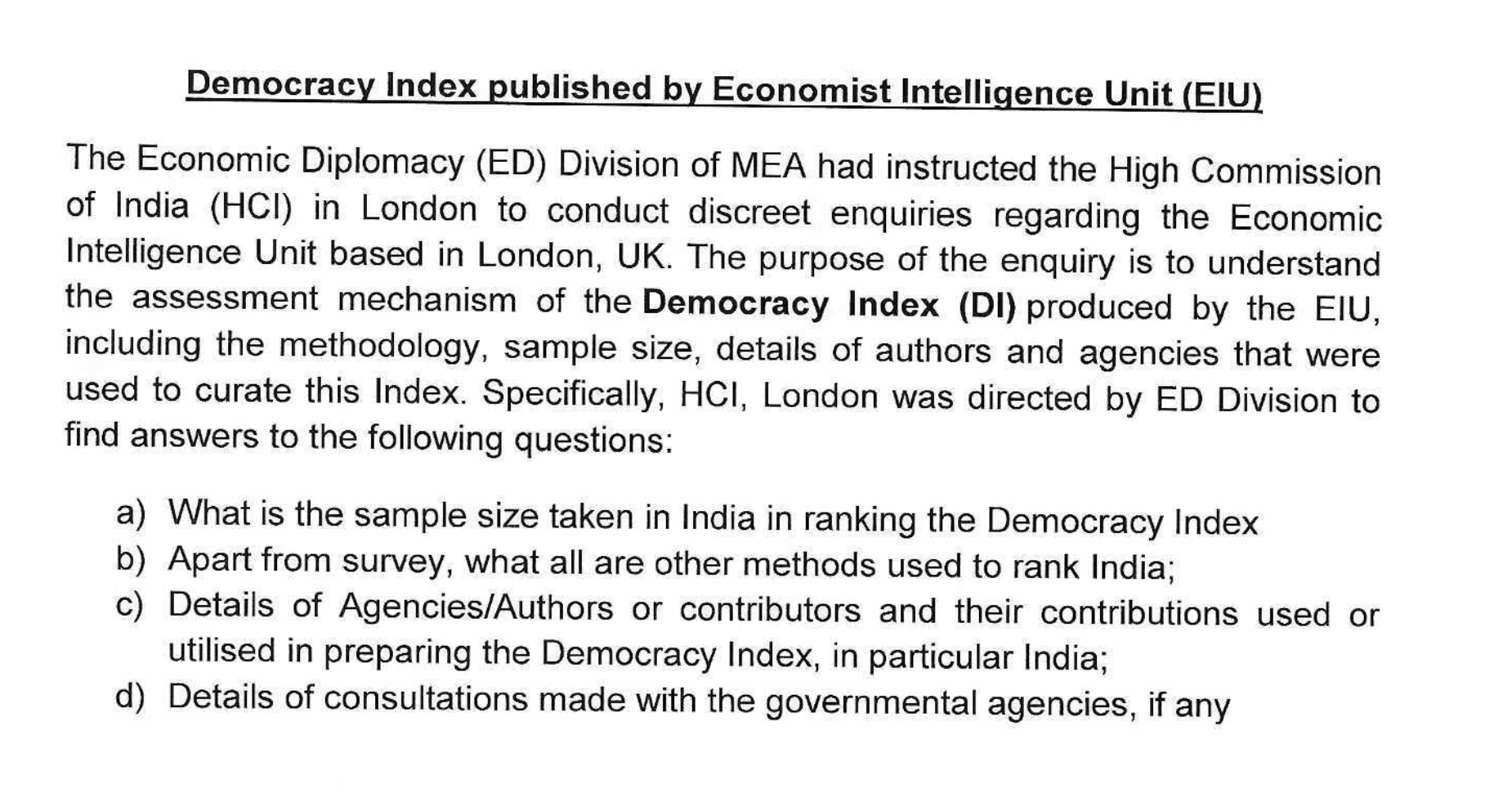
According to internal documents I accessed from July 2021, the initial outreach received a lukewarm response. Siu acknowledged the request and told officials she would “look into it”, adding that she would visit the High Commission in London once the coronavirus lockdown restrictions eased. But months of follow-ups and emails went unanswered.
It was only after sustained efforts that Siu eventually agreed to a virtual meeting.
During the Zoom call, Siu outlined EIU’s methodology. The Democracy Index, she explained, was based on 60 questions—split between qualitative and quantitative assessments—covering five broad categories: electoral process and pluralism, civil liberties, political participation, functioning of government, and political culture.
When officials pressed further, Siu made one point clear: government data was not a primary source: “Ms Siu politely but firmly declined the offer from the Mission to supply data, research or similar inputs.”
While EIU reviewed official reports from institutions such as the Reserve Bank of India and Finance Ministry, these were only considered supplementary. The index itself relied heavily on independent sources, including Freedom House, Pew Research, Human Rights Watch, and Reporters Without Borders, among others.
Officials then pressed on another point: Had EIU consulted government agencies before assessing India?
Siu’s response was unambiguous:
...she asserted that at no point does the EIU consult governmental agencies, as their work is fiercely independent of any external interference. Concerned entities are informed and sent a copy of their report.
That left the government with little room to maneuver. If India’s Democracy Index score was to change, it wouldn’t be through dialogue with EIU. These rankings were shaped by external institutions, following their own processes—processes that did not accept government input beyond publicly available data.
This was July 2021. (As of writing, the government’s Global Indices for Reforms and Growth project—which monitors India’s standing across international rankings—is still active. The Democracy Index remains on the list.)
But by then, something had already shifted. The government was no longer just tracking rankings—it was thinking about controlling them.
A parallel effort had emerged—one that had nothing to do with data inputs, methodologies, or policy reforms. Instead, it centered around managing the narrative around India's democratic decline. And it started with a letter.
IV.
In November 2020, Surya Prakash—retired head of India’s state broadcaster, Prasar Bharti—sat down to write a letter to Prime Minister Modi.
At 75, Prakash spent his retirement railing against Western biases. His walrus mustache and thick rectangular glasses made him a familiar face on news panels, where his soft-spoken delivery often masked the sharp edge of his arguments.
With India’s democracy ranking sinking, Prakash had a proposal in his letter to the Prime Minister:
This has gone on for many decades and remained uncontested. I feel that as the world’s largest and most vibrant democracy, we must define democracy and judge other nations and not the other way round.
A. Surya Prakash in letter to PM, November 2020
Prakash saw a contradiction: How could theocratic states with no separation of religion and government score higher than India? How could a country with universal suffrage and constitutional rights rank below nations that didn’t even hold elections?
He had a point: Who gets to decide what democracy means?
Democracy Index Debate
Debates around democracy indices aren't new. The Indian government isn't alone in raising concerns about the methodologies behind these rankings. Experts have frequently highlighted that assessing democracy involves subjective judgments, and various approaches often lead to differing conclusions. Our World in Data offers a detailed overview of how leading indices—such as V-Dem, Freedom House, and EIU—approach these complexities and when each measure is most useful.
This was precisely the conflict the Indian government chose to seize on. If democracy was not a fixed standard, but a contested idea, India could argue that the West had no exclusive right to define it.
Ordinarily, such a letter might have quietly disappeared under scores of such letters and suggestions the Prime Minister’s Office (PMO) receives on a daily basis. But this time, something unusual happened.
The PMO took Prakash’s proposal seriously. That same month, it forwarded a note to the MEA, instructing officials to examine the proposal. Within months, this letter became a catalyst for what eventually evolved into India’s official strategy.
To understand how this happened, it’s not enough to follow one letter, one note, or one decision. The best way to see it is to understand the mindset behind it—the way the government views narratives, legitimacy, and control.
V.
Nowhere is this mindset articulated more clearly than in the confidential Group of Ministers (GoM) report on Government Communication—a document I accessed, which starkly outlines how the government plans to shape and control the information ecosystem itself.
This select team of nine ministers included Ravi Shankar Prasad, Smriti Irani, Prakash Javadekar, S. Jaishankar, Hardeep Singh Puri, Anurag Thakur, Kiren Rijiju, Mukhtar Abbas Naqvi and Babul Supriyo.
Officially, its mandate was straightforward: to improve government messaging—press outreach, media engagement, digital campaigns, the basic mechanics of communication. But inside closed-door meetings, the discussions went much further.
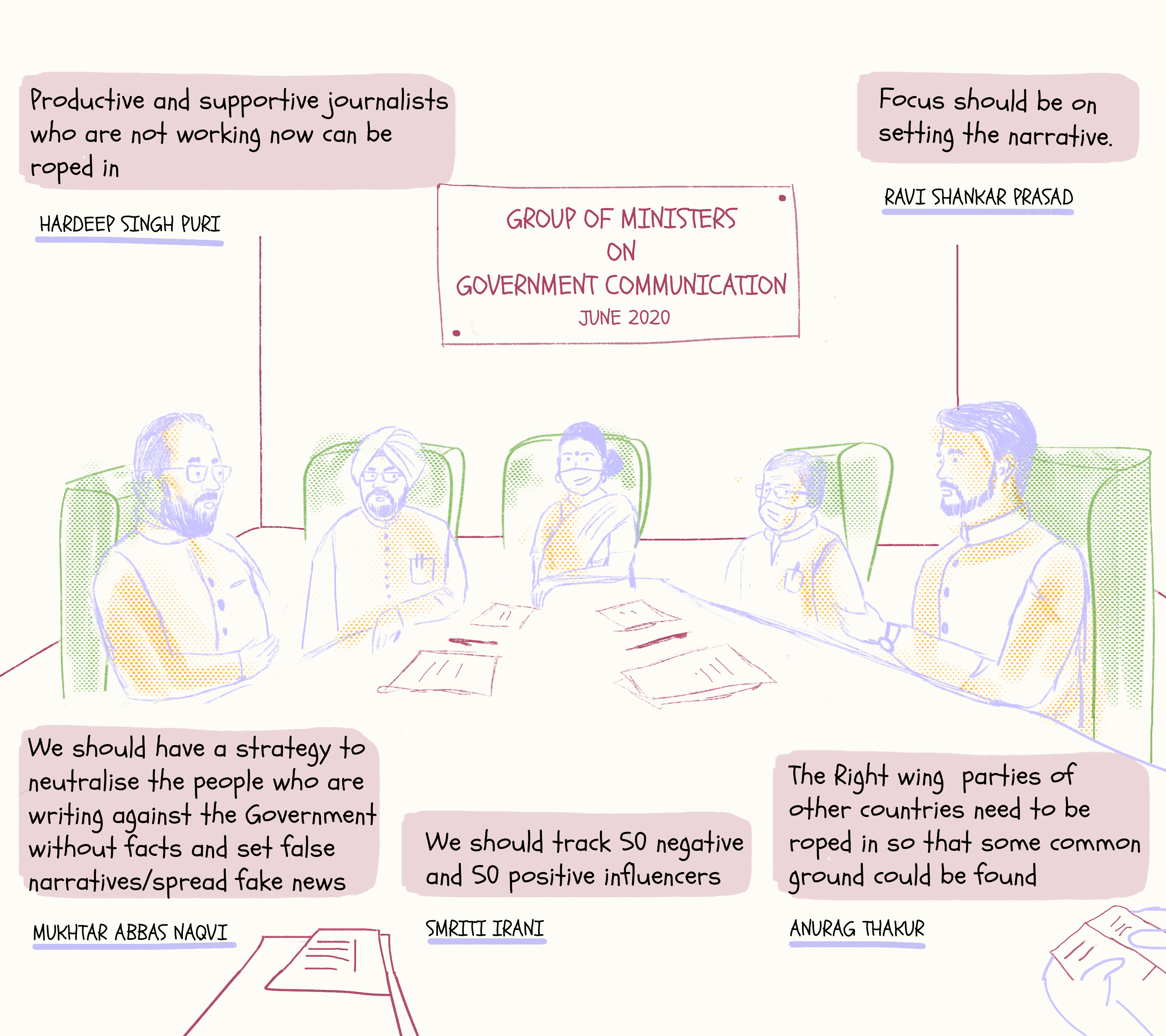
Ministers debated the need to track journalists and categorise them—separating those who were supportive from those who needed handling. They discussed how to systematically promote positive influencers while ensuring dissenting voices were pushed to the margins. There was agreement that messages from ministries, embassies, and political leaders had to be streamlined, so that there aren’t that many contradictions.
The strategy extended far beyond media engagement. It recommended closely tracking and responding to critical voices, while strengthening communication networks that could push back against unfavourable narratives. It outlined plans to amplify key government achievements, ensuring these became the dominant themes in public discourse.
One minister spoke about the need to “neutralise” those spreading false narratives. Another pushed for a more aggressive approach to shaping global perception.
The GoM report, compiled after these discussions, documented a methodical, structured strategy to control narratives across multiple levels—from media and academia to international platforms.
Full GoM Report on Government Communication
You can access and read the 97-page report here.
The government was no longer just shaping narratives. It was setting the terms of what could be said—and who had the authority to say it.
VI.
In March 2021, the PMO directed the MEA to prepare a formal presentation on the “Robustness of Indian Democracy”—an attempt to reframe how India’s democracy was seen globally.
This presentation portrayed democracy not as a system built solely on individual rights, institutional independence, and checks on power, but as a civilisational inheritance—rooted deeply in mythology, even citing the Ramayana as evidence of ancient self-governance.
It highlighted election officials trekking to remote Himalayan villages to collect just 16 votes, or setting up polling booths in Gujarat’s Gir forest for a single voter. It emphasised how democratic politics had peacefully transferred power from urban elites to previously marginalised groups, describing this as a social revolution achieved through ballot boxes. Above all, it underscored democracy’s success in holding together a nation of 4,635 distinct communities—including a population where 19.4% are religious minorities, speaking dozens of languages and expressing countless traditions politically.
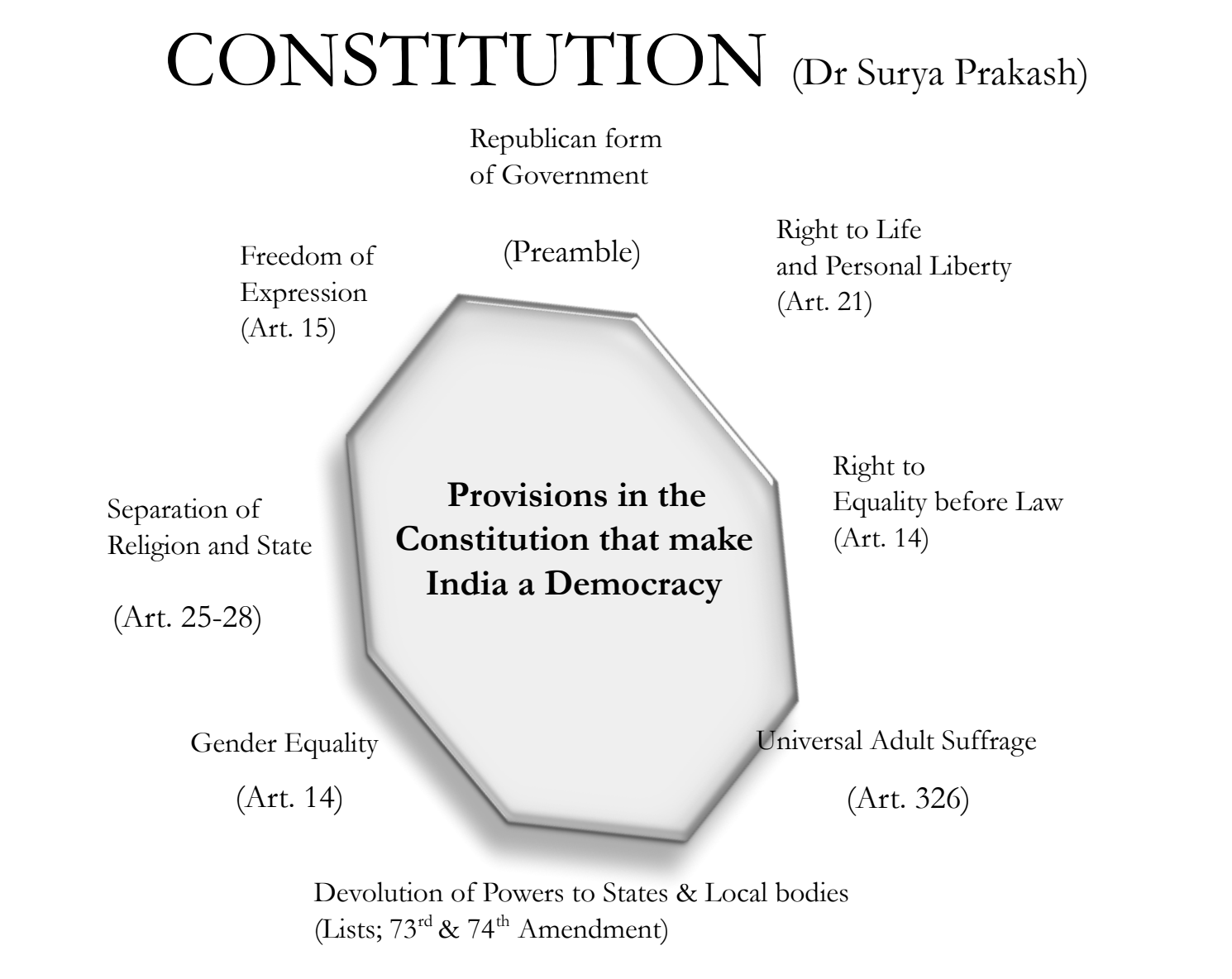
Surya Prakash’s ideas were prominently featured, receiving an entire slide in the 33-slide presentation. (His influence on the government’s thinking was ultimately recognised publicly. In January 2025, he was honoured with the Padma Bhushan—India’s third-highest civilian award—for his “well-researched interventions on national political issues.)
The underlying idea was simple: Western standards didn’t apply here. India had its own definition of democracy.
In August 2021, the government took this argument further. The MEA prepared “speaking notes” for Lok Sabha Speaker Om Birla to brief foreign diplomats. His task was to meet heads of foreign missions and explain India’s version of democracy—a narrative now fully articulated and backed by the state.
What made this move significant wasn’t just what was being said, but who was saying it. The Lok Sabha Speaker is meant to be an independent constitutional authority, separate from the executive. Yet here he was, delivering a government-prepared defense of India’s democracy.
At the same time, the government moved to limit domestic debate on democracy rankings. Twice, it attempted to prevent parliamentary discussions on the issue.
In July 2021, officials requested the Rajya Sabha secretariat disallow a question about “India's position on the democracy index,” claiming it was too sensitive for parliamentary debate.
When the topic resurfaced in February 2022—with an MP asking why India had fallen to 53rd on the EIU's Democracy Index—the government again sought to block the question. This time, it cited a procedural rule stating questions “shall not raise matters under the control of bodies or persons not primarily responsible to the Government of India.”
The implication was clear: since foreign institutions compiled these rankings, India’s democratic standing wasn't appropriate for parliamentary scrutiny.
This idea—that India should not just defend its democracy rankings but define them—didn’t remain rhetorical for long. It soon turned into policy.
In early 2023, the government began working on something new: its own democracy index.
The project was assigned to the Observer Research Foundation (ORF), a think tank that works closely with the government on international policy initiatives. As a senior government official told me, the task was to develop a homegrown ratings system that could act as an alternative to the Western-led democracy indices that India had spent years contesting.
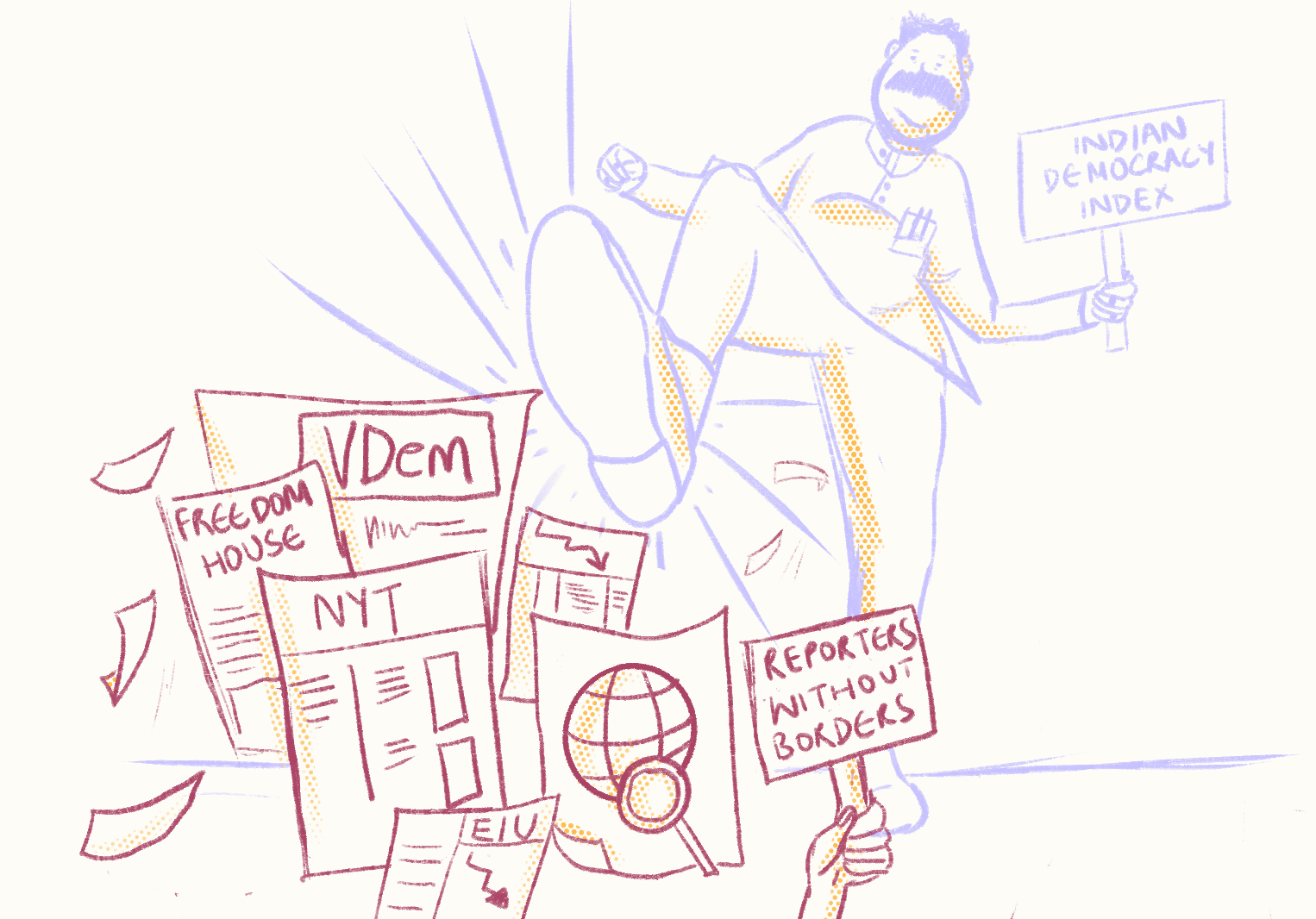
This was a statement of intent. For years, India had played by rules set elsewhere—by institutions shaped by Western liberal democratic ideals and reinforced through global indices. Until now, the government’s response had been to contest, critique, and push back against these methodologies.
But by moving towards creating its own index, India was adopting a different strategy. Instead of attempting to influence existing rankings, it was now constructing its own system.
VII.
These were the official efforts—the structured push to redefine democracy on India’s terms.
But alongside official efforts, another force was at play: who got more space in the debate—and who was pushed to the margins. The GoM report had already outlined the strategy—amplify friendly voices, discredit critics. Soon, that became visible in public discourse.
The government, along with right-wing media outlets, rushed to discredit V-Dem.
Much of this centered on funding sources—pointing out that V-Dem received support from the Open Society Foundation, run by George Soros, a long-time political villain in BJP rhetoric.
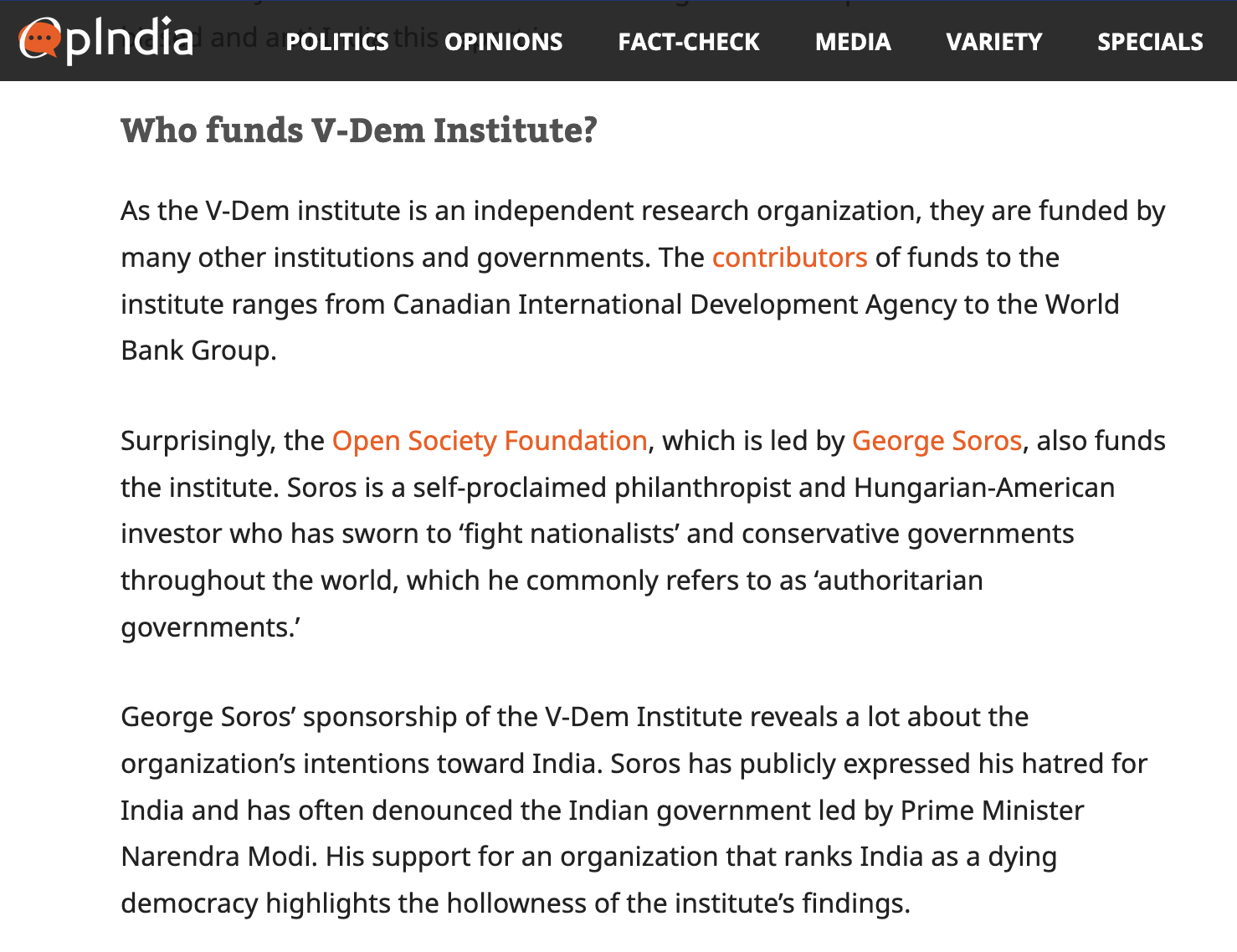
At times, these attacks entered official spaces. In Parliament, Rajya Sabha Speaker Venkaiah Naidu dismissed a question about India’s democracy ranking, saying:
What is the use of a Sweden report? These are all political. They should look inward. All countries which are commenting on India should first look inward and then comment on India.
Venkaiah Naidu
A coordinated campaign to discredit V-Dem followed—both online and offline.
At the same time, another voice suddenly emerged, quickly becoming a fixture in the debate.
In 2022, at the India Today Conclave, Salvatore Babones, an American-born sociologist, was introduced as a contrarian voice on India’s democratic health.
India’s intellectual class is anti-India...They are certainly anti-BJP and anti-Mr Modi, as a class.
Salvatore Babones in 2022 at India Today Conclave
It was the first time many Indians saw a Western academic forcefully defending India’s democracy on prime-time television.
Babones’ core argument revolved around who was assessing India in the first place.
“The experts at V-Dem, I have to stress, are mostly people in India,” he told me in an interview. “How do they know whether or not the electoral commission is independent? None of them were on the electoral commission. None of them were interviewing members of the electoral commission. They’re all just giving their impression.”
To Babones, these rankings weren’t measuring democracy itself, but the sentiments of an elite—and, he claimed, that sentiment had simply shifted. There has been no actual change in India from 2004 to 2014 to 2024, he told me. “The only change is that the experts are now depressed, when the experts were previously happy.”
His argument resonated in certain circles. And suddenly, his views were amplified across government-aligned media.
Babones had found the right moment, the right platform, and the right audience—and from there, his message spread.
All of this reflected the style of governance the GoM report had outlined—governance through narrative control. The homegrown democracy index, diplomatic messaging, discrediting critics, amplifying supporters, and carefully managing public discourse were all parts of this strategy. In this worldview, public discourse was not a space where ideas could freely co-exist, but a battleground where the state had to assert dominance.
And at least to me, that doesn’t sound democratic. (The ORF’s Democracy Index would disagree, I am sure.)
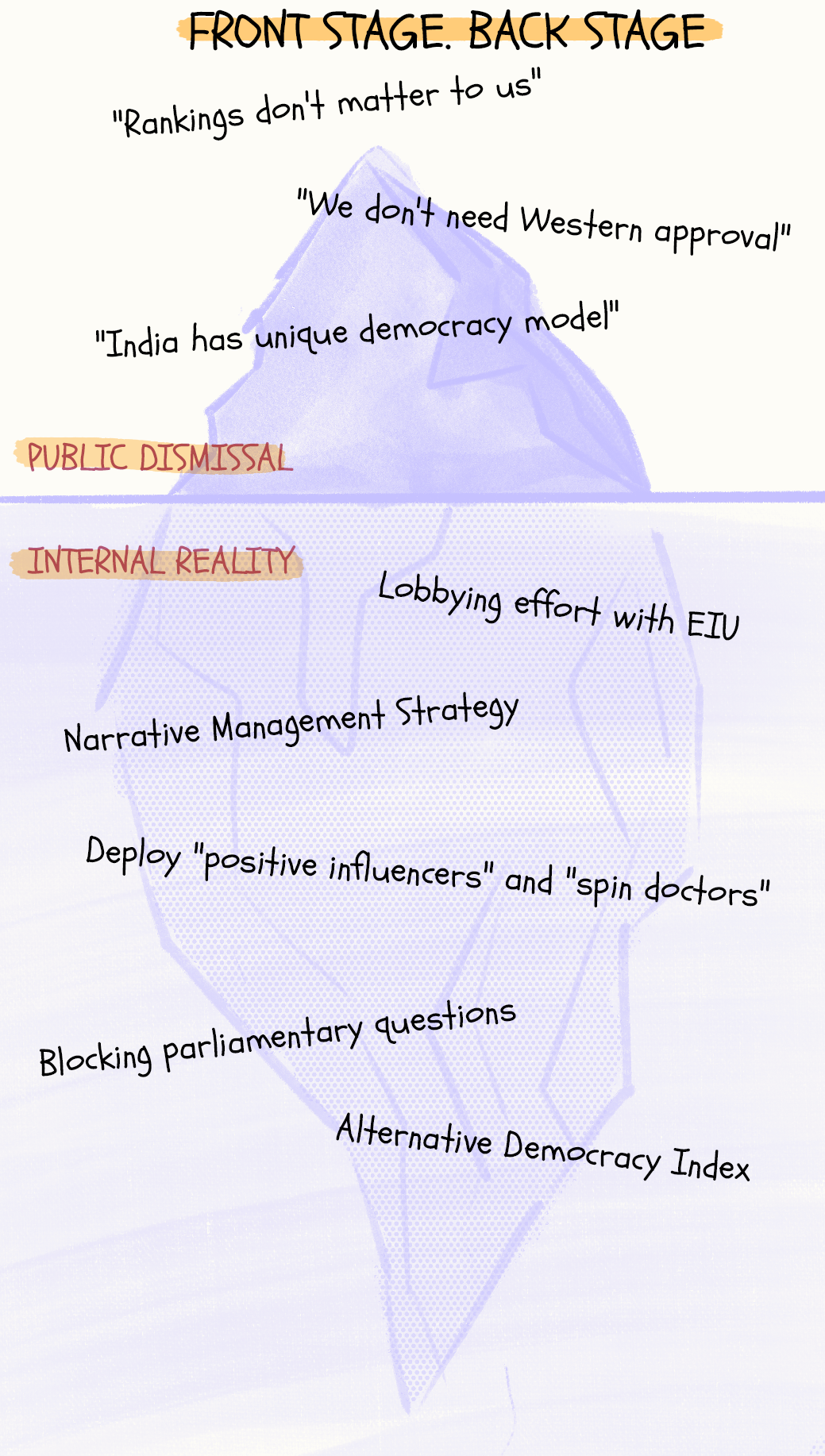
VIII.
Staffan Lindberg, the director of the V-Dem Institute, had seen governments react badly to democracy rankings before. Turkey under Erdoğan had lashed out. Hungary under Orbán had tried to discredit the system. But India, he told me, was different.
“It’s been the most obvious and blatant reaction from a government and government officials,” he said in an interview.
In Turkey and Hungary, backlash against rankings was largely driven by party supporters. In India, however, it was the government itself—ministers, officials, diplomatic channels—leading the pushback.
“In the case of India, it’s been a stronger reaction—openly from government and government officials. And a more blatant defamation campaign in trying to discredit V-Dem, The Economist, and Freedom House.”
But what troubled Lindberg most was the impact on those within India who contributed to these rankings.
V-Dem, like other democracy indices, relies on local experts to evaluate conditions in each country. Their identities are kept strictly anonymous—a precaution taken everywhere from Sweden to North Korea—to protect researchers from potential pressure or retaliation.
“This is something we took very seriously from the beginning,” he said. “We are legally bound by Swedish and European law to protect their identity because of the potential threat.”
That threat, he explained, had become real in India.
We had two people on our advisory board from India—both famous professors. One was eventually more or less thrown out from his university, and both asked to be removed from the international advisory board because of the harassment they faced at home from BJP and their supporters.
Staffan Lindberg, Director of the V-Dem Institute
IX.
In February 2025, Donald Trump’s administration drastically cut the funding for the United States Agency for International Development (USAID), abruptly terminating numerous foreign assistance programmes—including several in India.
As more information surfaced on the programs funded by USAID, Sanjeev Sanyal, now a member of Prime Minister's Economic Advisory Council, framed this as evidence of a larger conspiracy, describing the move as the sudden collapse of a global “Deep State” influence network he had opposed for years.
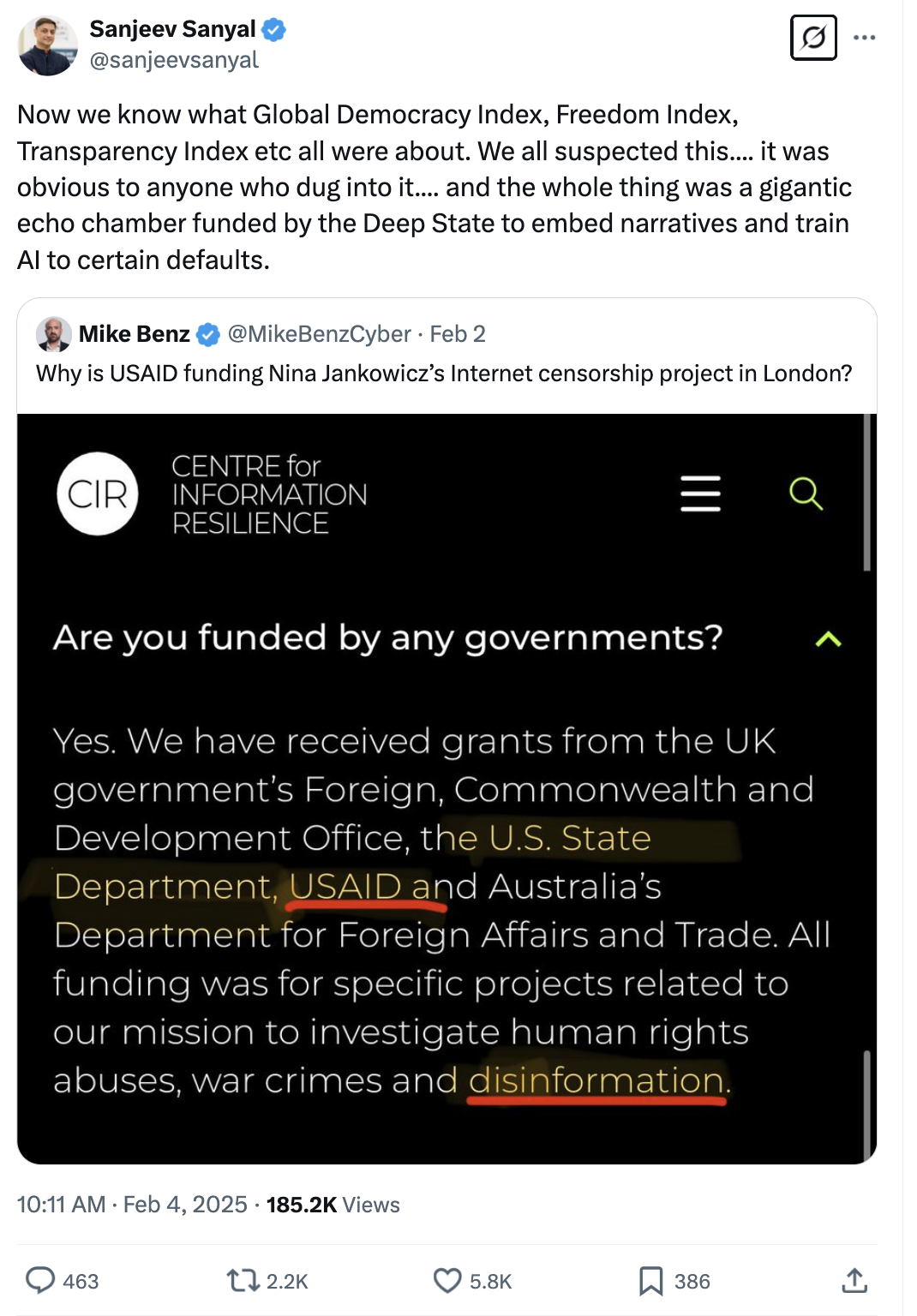
This was a far cry from the meticulous, data-driven critique Sanyal had once co-authored. That original paper was clinical in its approach: a breakdown of methodological flaws in democracy rankings, contradictions in scoring, and the arbitrary nature of perception-based metrics. It was the work of a technocrat dissecting a measurement system.
But now, that rigour had given way to something else—the simplicity of having an enemy.
The shift was complete. There was no longer a need to fix “flawed” rankings if the entire system could simply be dismissed as a conspiracy.
This evolution reveals a deeper truth: the point isn’t whether democracy indices are perfect—they aren’t. What matters is how criticism was met with efforts at delegitimisation. The “West vs us” rhetoric became a convenient weapon to discredit all criticism, emerging from a fundamental frustration: unlike with domestic media, the government couldn’t control global discourse.
And here, between the government’s public dismissals and private scrambling, lies a revealing contradiction: a democracy that claims strength but cannot tolerate scrutiny.
Because in the end, the numbers weren’t the real problem. The fear of losing control was. And that—more than any index—reveals where Indian democracy truly stands.
For feedback and comments, write to the editor at samarth@theplankmag.com


